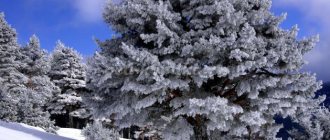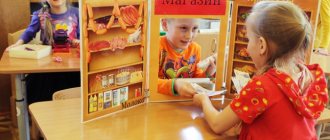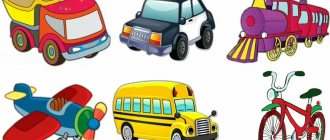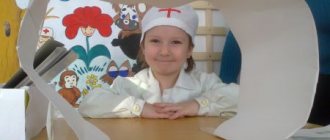Personal website of Valentina Nikolaevna Bulygina
The fourth week of January was dedicated to the theme “Home. Kuban courtyard." The children looked at pictures and illustrations on the theme “Houses”, “Fairy-tale houses”, “Kuban hut”, “Houses of different nations”; what materials were previously and are modern houses built from? We conducted a lesson to familiarize ourselves with the world around us, “This Wonderful World,” where we summarized children’s knowledge about various types of housing.
At a speech therapy lesson, the fairy tale “The Three Bears” (adapted by L.N. Tolstoy) was retold based on a series of pictures. We read, retold and looked at pictures from the fairy tale “The Three Little Pigs” in books.

We watched the cartoons “About Construction” and “Special Equipment”.

Cartoon "The Three Little Pigs".
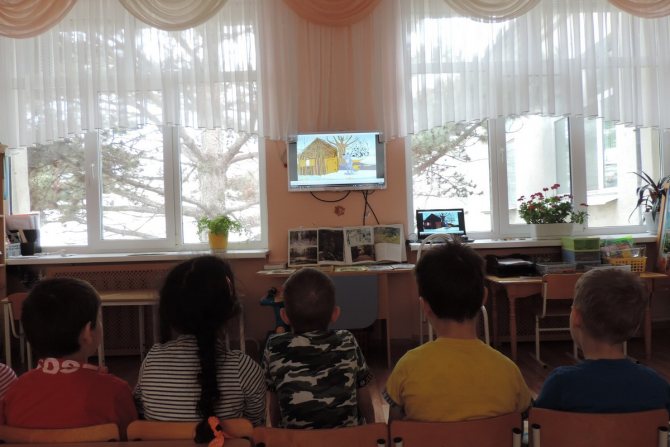
We conducted drawing classes on the theme “Fairytale Houses” and on the fairy tale “The House of the Three Little Pigs.”
The final stage was a theatrical game on the theme “The Three Little Pigs”.
Summary of the theatrical game in the senior group on the theme: “The Three Little Pigs”, 01/30/2018.
Objectives: To teach children to understand the emotional figurative content of a fairy tale, its idea, and to compose a story according to the scheme. To develop children’s desire to create images in theatrical play, to use intonation, dance, song, and play improvisations, to convey the character of the characters in the fairy tale.
Preliminary work: Examination of pictures and illustrations on the theme “Houses”, “Fairytale houses”, “Kuban hut”. Reading, retelling, looking at pictures in books based on the fairy tale “The Three Little Pigs.” Watching cartoons on TV: “About Construction”, “Special Equipment”, “The Three Little Pigs”. Drawing “Fairytale Houses”, based on the fairy tale “The Houses of the Three Little Pigs”.
Material: Three little pigs' flat houses, circus house, piglets' hats, wolf costume, diagrams.
Move
Children approach the house, stand in a semicircle, and greet the builder.
Educator: What a beautiful house you built, round, bright, I just want to look into it. Is this a circus?
In our Anapa, many new houses have been built for people to live in, many shops, but the circus comes only in the summer. Why?
Builder: Look in my folder, read the diagrams, tell a story based on them and you will understand everything.
The folder contains diagrams for the fairy tale “The Three Little Pigs.”
Educator: Now we will analyze the schemes one by one and begin.
Children take the diagram under number 1, then under number 2 and so on, for a total of 5 schemes. Five guys take part, the rest sit down as spectators in the hall and prepare for the performance, changing clothes.
- Once upon a time there were three little pigs, three brothers. (On the card there are three circles with two holes in each - spots).
- All of the same height, round, pink, with the same tails. (On the card there are 3 large pink circles, inside of which there are small circles with two holes in each and a hook-tail drawn from the large circle).
- Even their names were similar. The piglets' names were Nif-Nif, Nuf-Nuf and Naf-Naf. (Names are printed on the cards.)
- All summer they tumbled in the green grass, basked in the sun, and basked in puddles. (On the card there is sun, grass, puddles).
- But then autumn came. (On the card there is a tree without leaves, bending from the wind, clouds).
Educator: Well done, guys, you told the beginning of the fairy tale, now we’ll see what happened next.
The children who told the story sit down, and the child artists show the story.
Educator: All summer the piglets had fun, basked in the sun, basked in puddles.
Children wearing pig hats go out into the middle and dance to cheerful music.
Educator: Naf-Naf once said to his brothers.
Naf-Naf: It's time for us to think about winter, I'm shaking all over from the cold. Let's build a house and spend the winter in it all together.
Sketch ( the piglets answer their brother). Children dressed as pigs lift their houses from the floor - straw, twig and brick, and show the child spectators the fairy tale to the end.
Educator: Well done guys, it turned out to be an interesting game. Who guessed why the circus comes to us only in the summer?
It’s true, the city doesn’t yet have a warm, strong building for it so that the artists don’t freeze in winter.
01/31/2018 at 22:51. Headings: Classes, Photos.
Summary of GCD for FEMP “Let's help the three little pigs”
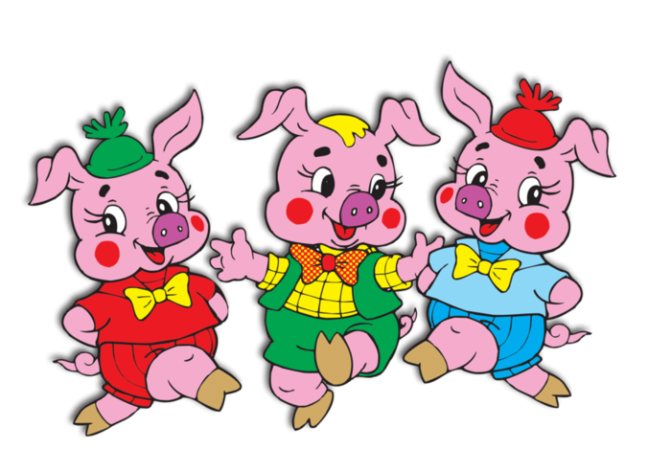
Program content.
— Give concepts about counting within 3, using the following techniques: when counting with the right hand, point to each object from left to right, name the numbers in order, coordinate them in gender, number and case, relate the last number to the entire group of objects. - Exercise in comparing two groups of objects, determining their equality and inequality based on comparison of pairs, learn to denote the results of comparison with the words: equally, more - less, as much - as. - Practice comparing two objects by size (length, height), denoting the results of the comparison with the appropriate words: long - short, high - low. -Practise the ability to distinguish and name familiar geometric shapes: square, triangle, rectangle.
Didactic visual material.
Demonstration material. Flannelograph (board), pictures depicting three little pigs and 3 acorns. Handout. Paths made of paper of different lengths (2 pieces for each child), Christmas trees of different heights (2 pieces for each child), geometric shapes cut out of paper (square, triangle, rectangle) (1 piece of each figure for each child) , sheets of white paper for each child, glue, oilcloths, napkins.
Preliminary work. Reading the fairy tale “The Three Little Pigs”
Description of GCD for FEMP.
1 part:
The teacher organizes the children near the flannelgraph (board). The teacher attaches pictures of three little pigs to the flannelgraph.
- Guys, look, the piglets have come to visit us. Let's remember their names (Nif-Nif, Naf-Naf, Nuf-Nuf). What do you need to do to find out how many there are?
(Count)
The teacher reminds how to count piglets, how to make a generalizing gesture and say “three little pigs.” Invites several children to count the piglets.
- Guys, our piglets love acorns, let's treat them to acorns. The teacher places two acorns on the flannelgraph.
— Tell everyone, have you had enough acorns? (No) How many piglets didn't have enough acorns? (To one) Let's check, count the piglets and acorns. (Three little pigs and two acorns) What's more? (Piglets) How many? (one) What less? (Acorns) How much? (for one)
- So how many acorns should you add? (One) Let's add one acorn. - Now everyone has the same amount? Let's check. To check, we will first count the piglets, and then the acorns.
Children count. (Three little pigs and three acorns)
— There are as many acorns as there are piglets. This means that all the piglets will have one acorn, and everyone will have an equal amount.
Didactic game: “Let’s play”
- Guys, let's play with the piglets. How many piglets do we have? (three) How many acorns do we have? (Three) Listen carefully: We will sit down as many times as we have piglets. Let's stand on our toes as many times as we have acorns. (Well done boys)
Part 2:
- Guys, the piglets are running away from the wolf, and they ask us to find the shortest road to get to the house. Let's sit down at the tables. You have paper paths on your tables. What can you say about the length of the tracks? (They are different. One is short, the other is long). Show me the long path. Show me a short track. Tell me, which path will the piglet take to get to the house faster? (On a short track) Show a short track.
Part 3:
— Guys, you have two Christmas trees on your tables. One Christmas tree is high, the other is low. Show me a tall Christmas tree. Show me a low Christmas tree. Guys, behind which Christmas tree is it better to hide a pig’s house (Behind the tall one) Show me the tall Christmas tree. (Well done guys)
Physical education minute.
- Guys, let's stand up (children rise on their toes and stretch their arms up) and show a high Christmas tree, and now a low one (squat down). Repeat the exercise 2-3 times.
Part 4:
— Guys, what time of year is it now? (Autumn) It’s cold outside, let’s help make houses for the piglets.
— Guys, you have geometric shapes on your tables. What shapes? The teacher takes out the figures one by one and asks for the names. (Square, triangle, rectangle) Let's see how these figures are similar and how they differ? (Everyone has angles, sides, a triangle has three angles and three sides, squares have equal sides, rectangles do not have all the same sides). We will now make a house for piglets from these figures. Let's take a square. This will be the house itself. What shape will we make the roof from? (From a triangle) What shape will we use to make the door? (From rectangle)
(Children glue.)
- Guys, the piglets really liked your houses, now they can always hide in them from the wolf. And together with you, they have learned to count to three, they know that it is faster to run from a wolf along a short path, and they can hide behind a tall Christmas tree.
Author: Olga Vladimirovna Khomchukova, teacher, MBDOU kindergarten No. 919, Moscow, Russia
The article is published in the author's edition
